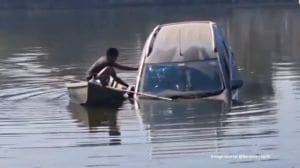Uttar Pradesh elections 2017: BJP formula — Traditional votebase & a gamble
BJP has also selected 69 candidates from landed backward castes, with 27 Kurmis, 20 Lodhs, 15 Jats and seven Gurjars becoming party nominees.
The results of the state elections, to be announced Saturday, will test the viability of BJP’s formula of combining its traditional upper caste support base with non-Yadav OBC castes and non-Jatav Dalit castes. This election, the party released a candidates’ list that was possibly its most diverse in terms of the social background of its nominees. It fielded 50 candidates from backward castes like Kushwaha, Saini, Maurya, Nishad, Rajbhar, Lonia Chauhan and Pal, the largest share since 1991, when the party had projected Kalyan Singh as its face in the state to reach out to backward castes after the implementation of Mandal Commission recommendations (which had a mandate to “identify the socially or educationally backward”).
BJP has also selected 69 candidates from landed backward castes, with 27 Kurmis, 20 Lodhs, 15 Jats and seven Gurjars becoming party nominees. Their support will determine not just the party’s performance this election, but also its chances of maintaining a strong support base in the state. “We have been fielding candidates from non-Yadav backward castes in all elections, but their number was never so large. Most importantly, these castes are now open to supporting BJP because of Prime Minister Narendra Modi’s appeal in these sections,” said a leader.
The BJP also significantly reduced the number of its Yadav candidates to eight, its lowest since 1991, as the party ran a campaign which highlighted the dominance of “one caste” under the Samajwadi Party’s rule.
To counter BSP chief Mayawati’s attempt to consolidate the Dalit vote, the BJP gave representation to non-Jatav Scheduled Castes. Though Jatavs form about 57 per cent of the state’s Dalit population — which is about 22 per cent of the state’s total population — it gave tickets to only 23 Jatavs. On the other hand, it selected 21 candidates from the Pasi caste, the second largest Dalit caste which forms about 16 per cent of state’s Dalit population. More importantly, it selected 34 candidates from smaller Dalit castes like Kori, Dhobi, Khatik, Balmiki, Nat, Beldar, Baheliya and Gond, which comprise less than 25 per cent of the state’s Dalit population, but are not strictly attached to BSP like the Jatavs.
BJP not just inducted over a dozen OBC leaders from the BSP, including former Leader of Opposition in the Assembly, Swami Prasad Maurya, it also allied with two parties — Suheldev Bharatiya Samaj Party of Om Prakash Rajbhar and Apna Dal (Sone Lal) of Anupriya Patel — outfits known as representatives of the Rajbhar and Kurmi castes respectively.
An analysis of the caste backgrounds of BJP candidates since the 1991 Assembly elections by The Indian Express shows that the percentage of candidates from poorer backward castes — known as most backward castes(MBCs) — is for the first time in double digits. Moreover, they form 13 per cent of all candidates.
These groups were known for supporting SP and BSP in the last few elections, but in the 1990s, they had increasingly aligned with the BSP as they found themselves closer to Dalits in the social hierarchy of villages. Besides poaching a number of BSP leaders, the BJP also reached out to these groups by appointing Phulpur MP Keshav Prasad Maurya as the party’s state chief. In UP, BJP leaders have often highlighted that prime minister himself belongs to the most backward Teli caste.


- 01
- 02
- 03
- 04
- 05





























